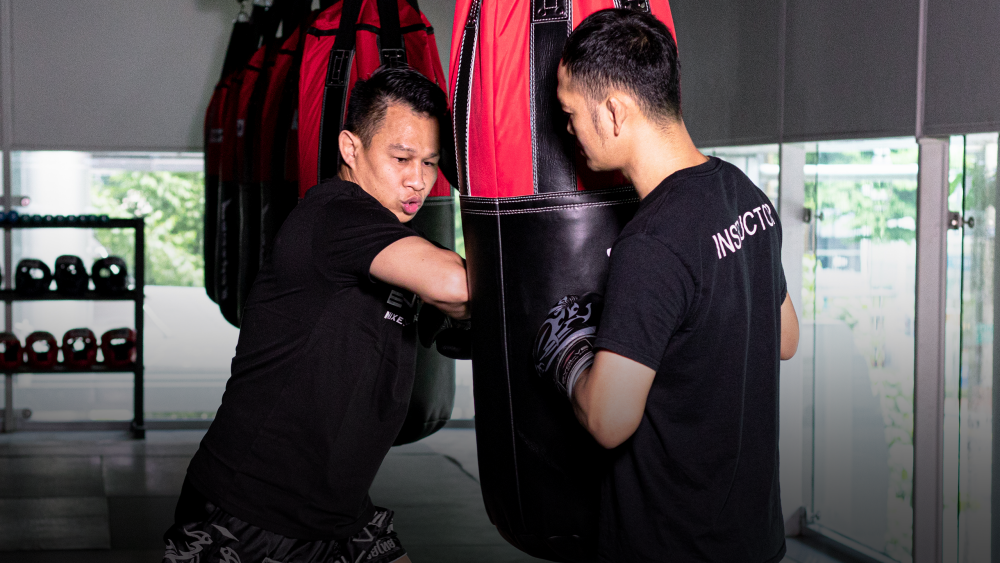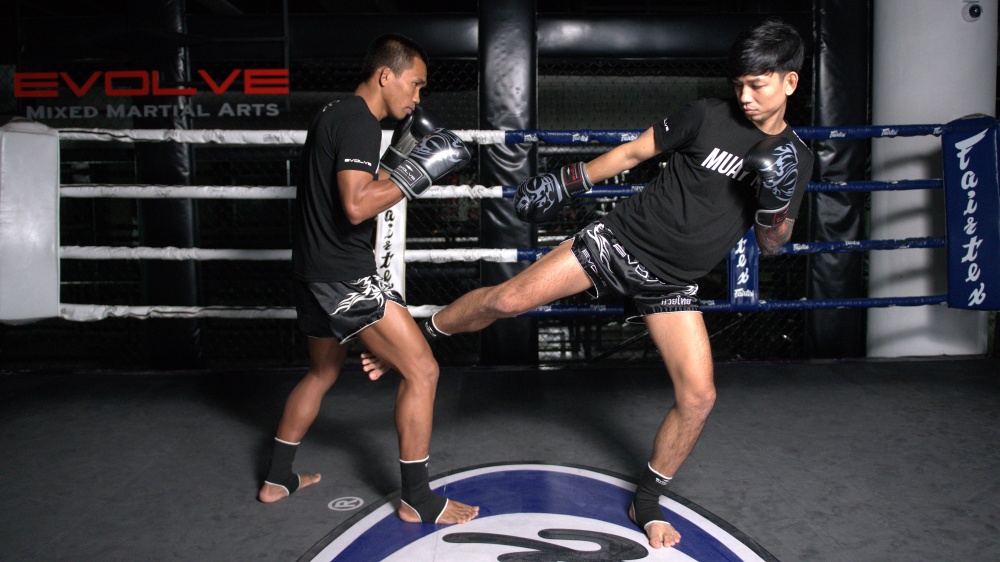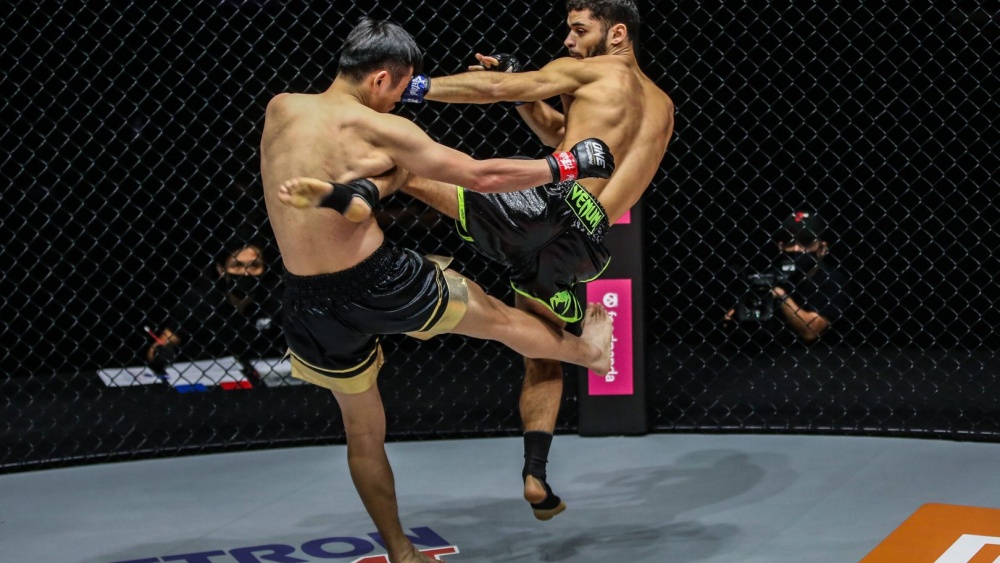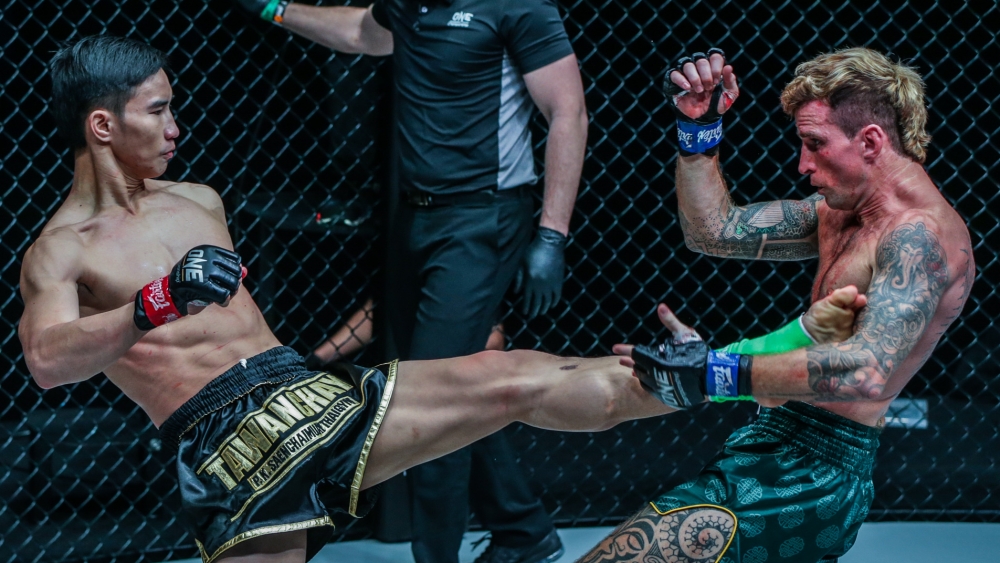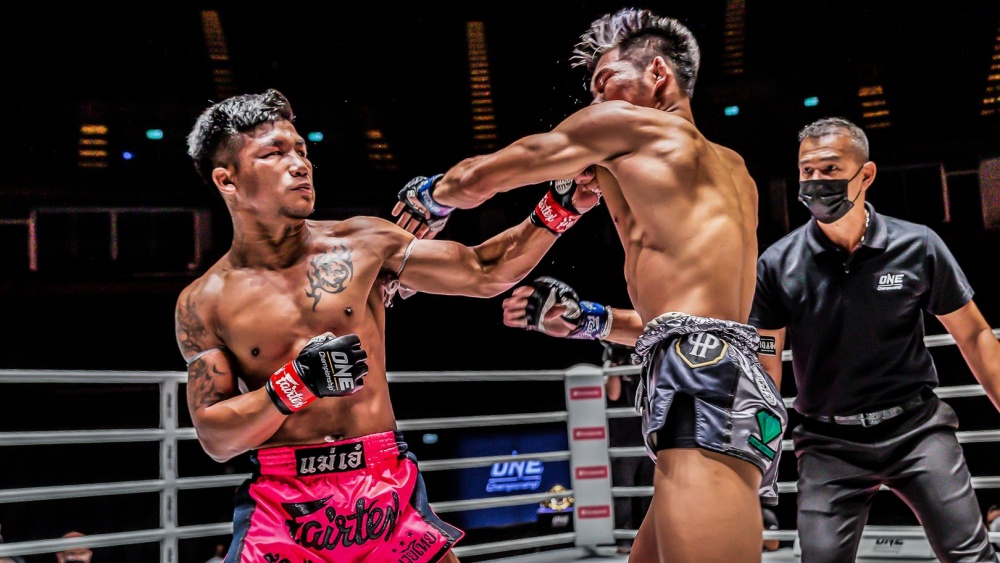When you begin learning Muay Thai, the sheer number of strikes, skills, and positions you need to memorize can be daunting. In fact, you could spend half of your first few months of training, scratching your head as you try and recall all of the moves you’ve been taught, especially if you progress quickly.
To help you out, we’ve created a glossary of some of Muay Thai’s key moves and positions. We have included a brief definition of each Muay Thai term and, to help jog your memory, we have included the key points of performance for some of the more complex movements.
1) Jab
A straight punch thrown from the lead hand. The jab isn’t considered a power shot and is typically used to control range and create openings for other strikes.
2) Cross
A powerful straight punch thrown from the rear hand.
3) Hook
A horizontally looping punch that travels in a half-circle to target the side of an opponent’s head and jaw.
4) Uppercut
A vertically looping punch in which the fist travels downwards before it’s driven up beneath an opponent’s chin.
5) Body-Rip/Body-Hook
This looping punch follows an angled line, midway between a hook and uppercut to target the side of an opponent’s body. The fist will target the floating rib, but power is driven upwards at an angle as if your fist is going to travel through the body and out of the opposing armpit.
6) Spinning Back Fist
To deliver this difficult, spinning punch you first need to step across your body, turning your back to your opponent before simultaneously extending your arm and spinning through to face them again. Your arm will whip out behind you to strike around the side of your opponent’s head. Unlike typical punches that are delivered via the knuckles, the side or back of a closed fist is what makes contact in this strike.
A superman punch is delivered following a feinted kick. If, as you lift your leg, you notice your opponent open their guard to block or catch, throw your extended leg back out behind you with as much force as you can muster. Throw a straight hand from the same side as your feinted kick and as the leg drives back, your upper body will naturally swing forward, creating the power needed to rock your opponent. For extra range and power, try skipping forward on your standing leg as you shoot your feinted leg out behind you. Ideally, when you land this strike, your entire body (barring the standing leg) will be horizontal, like Superman flying through the sky.
8) Overhand
A rear punch that loops high over an opponent’s guard before smashing downwards head in a motion similar to a freestyle swimming stroke. To maximize the momentum on this punch you need to step in close and roll your head forward as if you are looking towards the floor.
1) Crossing Elbow
A crossing elbow is delivered with the lateral movement of your pointed elbow and power is generated with similar foot and body rotation to a hook. There are two slight variations on the crossing elbow; the horizontally cutting elbow, which moves directly in a straight line, and the diagonally crossing elbow which follows the line of an overhand punch, cutting down on the temple.
2) Spike Elbow / Downward Elbow
This elbow moves vertically, almost like a hammer crashing down on top of your opponent’s skull. To perform this strike, you need to rear your bent elbow up high before slamming it down on your opponent’s forehead, to get extra power consider “hopping” into range so that your elbow strikes as your entire body weight descends onto the other fighter’s head.
3) Uppercut Elbow
An uppercut elbow isn’t delivered exactly as its name would suggest. While your footwork and body will rotate vertically in the same way that you would throw an uppercut, and you will “comb your hair” with your glove so that your elbow moves upwards, it is actually forward movement that generates power for this strike.
To maximize the power of this elbow, time the upward rotation with an explosive step forward so that the point of your elbow connects with your opponent’s head like your elbow is a battering ram driving straight through them.
The spinning elbow is thrown almost identically to the spinning back fist. Except, after stepping across your body you don’t extend your arm so that it’s the point of your elbow that makes contact instead of the back of your fist. As you have far less range on this than a back fist, you need to ensure that you step closer, past the lead foot of your opponent.
5) Flying Elbow
The flying elbow lives true to its name. It requires you to leap from the canvas and launch yourself towards your opponent with explosive force. To maximize the power of your elbow, you should “cycle” your elbow-side leg in a similar way to your superman punch. This will maximize the forward momentum of your elbow as it crashes down into the top of your opponent’s skull.
6) Pull-Elbow /Strip Elbow
If your opponent has a tight guard, it can be difficult to find the space to slide an elbow between their gloves. To create an opening, you can “strip” their guard by grabbing their forearm with your palm and pulling their guard down to create the opening you need to land a slicing elbow.
1) Knee
A stabbing strike with the point of your knee. This can be done from in the clinch or at range. Power is generated by pushing off the ground with your striking leg and driving forward with your hips.
2) Roundhouse Knee
Sometimes, when clinching, you will find yourself too close to your opponent to drive a stabbing knee down the center of their body. In this case, you can whip your knee around the side of their body, striking them with the inside of your knee rather than the point. These knees are usually used as a distraction to create openings in the clinch because, unlike knees down the center, roundhouse knees don’t usually affect the scorecards.
3) Jumping Knee
This is a long-range knee strike delivered by jumping from range and driving your knee forward into your opponent’s stomach or head before you land back on the canvas.
4) Scissor Knee
This is a version of the jumping knee that begins with a feint. You will launch from the ground as if you plan to land your rear knee before “bicycling” your legs mid-air to deliver a strike off the opposing side. The cycling of your legs will “switch” your hips, often resulting in the scissor knee becoming more powerful than a conventional jumping knee if it is timed correctly.
The conventional Muay Thai kick that is perhaps the sport’s most common weapon. A fighter will use their shin to kick through their opponents’ ribs with power being generated via the horizontal rotation of their hips and standing foot. To maximize power a fighter will step outside of their opponents’ feet, throwing their kicking-side arm down as they lift their leg, amplifying the amount of weight they can rotate through their adversary.
2) Switch Kick
A kick fired from the lead leg. To generate power for an effective strike you need to “switch” your stance, bouncing quickly from orthodox to southpaw (or visa versa) so that your lead foot is behind you before you launch it at your opponent.
3) Head Kick
A variation of the roundhouse kick that targets the opponent’s head and neck. To reach the extra height a fighter will often kick their leg straight upwards, only rotating their hips and standing foot once their shin has reached the necessary height.
4) Low Kick
This is another variation of the roundhouse kick that targets the thighs and quads of an opponent. To generate as much power as possible, a fighter will raise their leg to the height of their opponent’s hips before “chopping” down on the outside of their leg as if their shin is an axe cutting a tree down.
The inside leg kick is thrown fast to the inside of the lead leg when a fighter is placing too much weight on their front foot. Unlike other kicks that strike with the shin, this strike doesn’t require much horizontal rotation, it is thrown almost directly upwards to the inner thigh and back of the hamstring as if you are kicking a football.
6) Teep
Teep is the Muay Thai term for push kick. Weight is shifted onto a fighter’s standing leg while their striking foot stabs outwards with the help of a hip thrust that creates power and extends the range of the strike. Usually, a fighter will lean back as they extend their leg to increase the range and assist with balance.
Whilst most kicks are thrown to inflict damage, the teep is generally used like a jab, to control range and create openings for other strikes. The front leg teep is fast and can be used to disrupt an opponent’s rhythm as they step into range whilst the rear leg is far more powerful and can launch an opponent across the ring.
7) Switch Teep
A variation on the teep that requires you to feint with one leg, “cycling” your hips at the height of your feint, causing a small jump as the alternate leg is thrust forward into your opponent’s body.
8) Shuffle Teep / Pendulum Teep
Most teeps are used defensively, meaning that an opponent needs to step into striking range before it can be thrown. The pendulum teep is more aggressive. To throw this variation you need to step your back leg directly behind your front foot before planting your weight onto it. This will skip you forward so that you can teep a distant or retreating opponent with your lead leg.
9) Axe Kick
This uncommon Muay Thai strike requires you to lift your extended leg high across the front of your body. Once it is overhead you will whip that straight leg down so that the heel of your foot smashes into your opponent’s head, jaw, or collarbone.
Another rare Muay Thai strike. This kick requires you to step across the front of your body before spinning so that your back faces your opponent. Once your foot has landed, you will kick straight out behind you with the opposite leg, like a horse bucking someone off its back. To maximize the power and height of the strike, you can lean forward so your head dips towards the canvas.
11) Spinning Hook Kick
The spinning hook kick begins in the same manner as the back kick, but rather than kicking out behind you after the step you continue to rotate, whipping your straightened leg out high so that your heel crashes into the side of your opponent’s head.
1) Feint / Slide
The act of faking a roundhouse kick by stepping forward and dragging your rear foot behind you as you lift your hip. To complete the feint, lower your kicking side arm slightly as you would if you were going to throw a kick.
2) Drop Step
The act of switching your stance by stepping your front leg back and rotating your shoulders. This is usually done as an opponent moves in to attack, so make sure that you keep your heel raised when your foot lands so that you can bounce directly into a roundhouse kick if needed.
3) Shuffle (Saenchai Shuffle)
The act of faking a switch-kick as popularised by the prodigal fighter, Saenchai. Quickly switch your stance to draw a reaction before immediately switching it back to throw a strike from your dominant stance while your opponent is off balance.
4) Death March
Oftentimes a fighter looking to engage in the clinch will wear a number of kicks and teeps as they attempt to close the distance between themselves and their foe. To defend against this, they can march forward with high knees, connecting their knees to elbows to create a strong block with every step that can protect them from kicks and cause their opponent to injure their foot when they teep them to the elbows and knees.
5) Pivot / Quarter Turn
Like a matador evading a charging bull, the pivot is used to step out of the path of an aggressive opponent whilst keeping them in the line of fire for your strikes. To successfully pivot, step your foot outside of the advancing fighter’s foot and turn ninety degrees so that they remain in your sights while they are still looking at the empty space where you used to be standing.
1) Long Guard
The long guard is a simple maneuver used to defend against punches whilst keeping your opponent at arm’s length. When an opponent begins to unload with a barrage of punches, shoot your lead arm out under their jaw while you lower your chin and cup the top of your head with your rear arm. This will cover your jaw and most of your head from punches whilst creating room for counterattacks of your own.
2) Parry
A parry is the act of redirecting an opponent’s straight strikes with your hands so that they miss their intended target. When an opponent throws a jab or cross you can use a small “swatting” motion with your gloves to knock their hand off course and unbalance them at the full extension of their strike and counterattack with your preferred strikes.
3) Over Catch
The standard catch used to defend against an opponent’s roundhouse kick. Step laterally away from the incoming kick whilst scooping their shin up high into your armpit. If done correctly it will look like you are attempting to place their ankle in a BJJ “Guillotine” choke.
4) Under Catch
When someone kicks higher up onto your arm or shoulder it can be difficult to land the conventional over catch. When this happens hold your defending-side arm tight to your body and as the kick lands onto your bicep, reach across with your opposing arm, scooping the underside of their leg before swinging it back the way you came.
5) Sweeps
There are countless Muay Thai sweeps that can be used in the clinch and as a defense against kicks. A sweep is any movement in which you kick out an opponent’s standing leg with your own. Generally, the lower you make contact with an opponent’s leg the easier it is to sweep them, so think of your foot as a broom dusting the ring canvas whenever you attempt one.
6) Dumps
A dump, usually delivered from the Thai clinch, is the act of throwing a standing opponent to the floor when they have both feet on the ground. Generally, a dump involves manipulating an opponent’s head and body position, throwing them over or around your own body to send them crashing to the canvas.
7) Blocks / Checks
The act of creating a wall with your arm and leg to block a kick. The perfect check usually involves making the foot or ankle of your opponent’s kicking leg collide with your knee or shin. Just make sure that your elbow slides to the outside of your knee to protect yourself if the kick targets higher than anticipated.
8) Lean Back
When a roundhouse kick is thrown too high for you to block or catch you can lean back to avoid it. Step back with your rear leg and lean your head back, lowering your lead arm so that it avoids your opponent’s shin. You should try to keep your lead foot stationary for this movement so that you are still in range to immediately counter your opponent when their kick misses your head.
Clinch Positions
1) Top Lock / Double Collar Tie
The most basic and dominant clinch position. It involves having both arms in the “inside” position with your arms wrapped around your opponent’s head, neck, and shoulders, like the collar of a shirt.
2) 50/50 / Half Collar Tie
A neutral clinch position in which both you and your opponent are vying for neck control with one arm in the “inside” position and one arm “outside.”
3) Body Lock
A clinch position that involves locking your arms around your opponent’s body with your hips in close to theirs, almost as if you have them in a bear hug. To maintain balance and create the opportunity to sweep, you need to ensure that your feet are placed wider than your opponent’s. When you are in the body lock position, you can also attempt the body lock dump on your opponent.
4) Seatbelt
This lock is a variation of the 50/50 position where one fighter has slipped under one of their opponent’s arms and has managed to pivot side-on to them so that they are looking across the front of their chest. Their arms will be clasped around their neck and chest, in the same way a seatbelt would drape across them. If you get into this position you need to ensure that you plant your feet wide, trapping their leg between your hips whilst pressing your head tight to their neck so they can’t turn back to face you.
You may also like:
The Complete Muay Thai Beginner’s Guide
